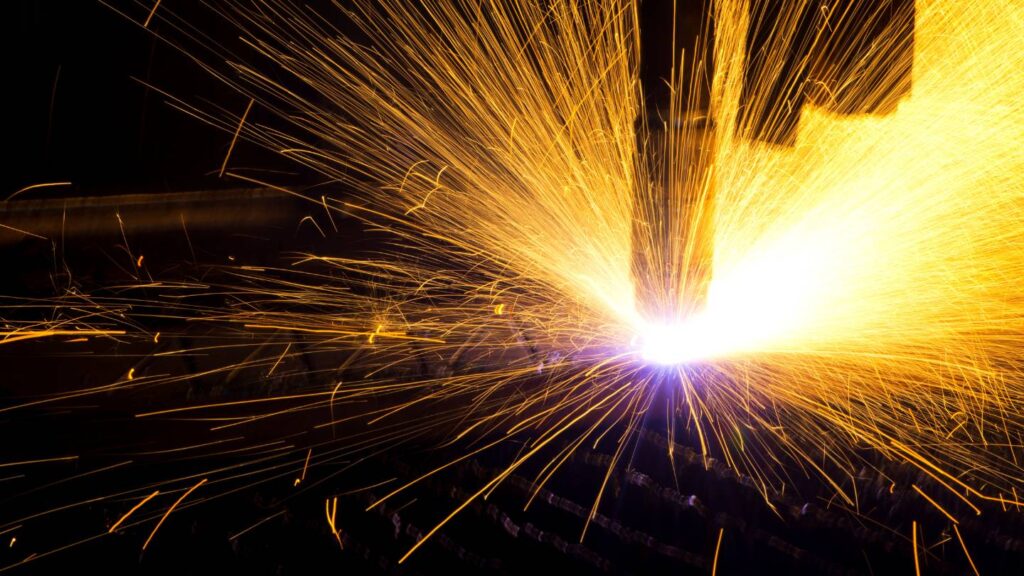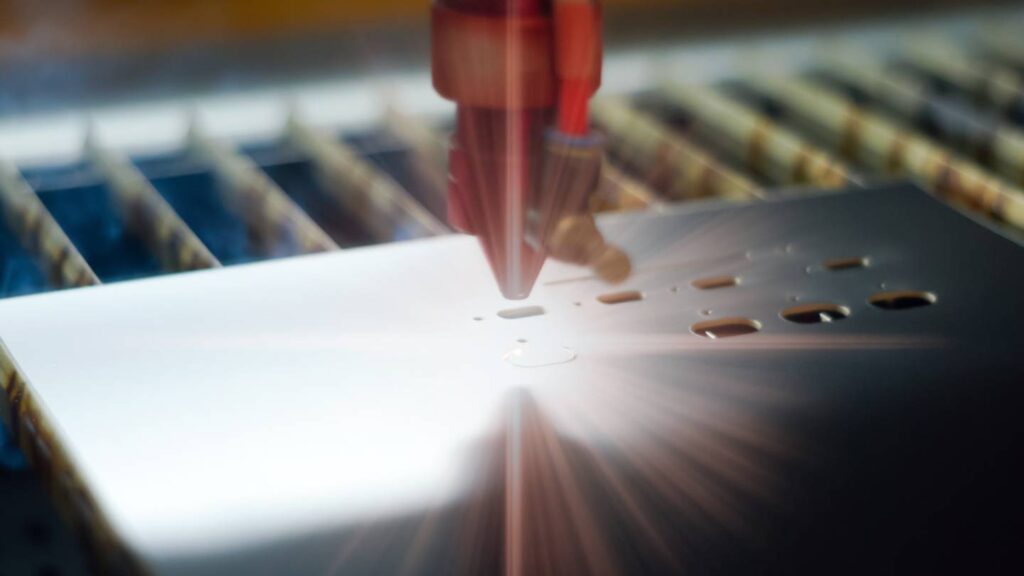When it comes to laser technology, there are a few different kinds of lasers, and each one has its own set of advantages and uses in different fields.
Among these, CO2 lasers are among the most common and flexible. The CO2 laser is well-known for its efficiency in cutting, engraving, and marking a wide variety of materials, including wood, acrylics, plastics, fabrics, and more. It emits an infrared beam of light by use of a gas mixture, usually carbon dioxide, nitrogen, and helium.
Carbon dioxide (CO2) lasers are widely used in industrial manufacturing, signs, and creative pursuits because of their accurate and detailed cutting capabilities at power levels ranging from a few watts to several kilowatts.
The fibre laser is another well-known variety; it is famously fast, precise, and efficient. In order to produce laser beams, fibre lasers use optical fibres as the gain medium. They provide high-quality beams, efficient energy use, and minimal maintenance needs, and they are particularly good at marking and cutting metals at high speeds, particularly aluminium and stainless steel.
Fibre lasers are highly regarded in the metal fabrication, electronics, aerospace, and automotive industries for their exceptional speed and precision while cutting metals.
Another common type of laser that uses semiconductor diodes to produce light is the diode laser. When compared to other kinds of lasers, diode lasers are small, efficient, and inexpensive. Their diminutive stature, adaptability, and reasonable price make them ideal for usage in a wide variety of applications, including but not limited to: laser pointers, barcode scanners, medical equipment, and communications.
Since solid-state lasers like Nd:YAG (neodymium-doped yttrium aluminium garnet) lasers can produce high-energy beams that are compatible with a wide range of materials, they find use in a number of industries and fields, including medicine, welding, and cutting.
The versatility and utility of laser technology across many sectors are enhanced by the exceptional qualities, specialised uses, and benefits of each type of laser, which are designed to meet the demands of various industrial, commercial, and scientific fields.
Table of Contents
What Is The Process Of Laser Cutting?
A high-powered laser is used in laser cutting, with the beam or material being guided by optics and computer numerical control (CNC). A motion control system usually follows a computer numerical control (CNC) or G-code pattern of the material to be cut. In order to achieve a flawlessly smooth surface finish, the concentrated laser beam is either burned, melted, vaporised, or expelled by a gas jet.
Stimulating lasing materials within a sealed container with electrical discharges or lamps produces the laser beam. The energy of the lasing material is increased by reflecting it internally through a partial mirror until it is sufficient to emerge as a coherent monochromatic light stream. By using a lens to concentrate the light, mirrors or fibre optics bring the light beam directly to the work area.
Although kerf widths as tiny as 0.004 inches (0.10mm) are achievable depending on material thickness, a laser beam's narrowest point is usually less than 0.0125 inches (0.32 mm) in diameter.
To start the laser cutting process anywhere else than the material's edge, a piercing technique is employed. This involves making a hole in the material using a high intensity pulsed laser; for instance, it takes 5-15 seconds to burn through a 0.5-inch-thick (13 mm) stainless steel sheet.

Methods For Determining Which Lasers Will Meet Your Requirements
Picking the right kind of laser to meet your application's demands is no picnic. There is a lot of overlap in the operational capabilities Venn diagram, and secondary factors like equipment price, ownership cost, and life expectancy make things even more complicated. Some of the things to think about when picking for a laser are as follows:
- You can cut down your options by having a clear and reasonable idea of the functional outputs you need.
- Determining the power and service frequency needed by the device is possible with a thorough understanding of the application. Bands, rather than precise degrees, are a useful way to think about powers. Cutting 0.2 mm steel uses tens of watts, whereas cutting 50 mm steel could need a thousand times as much power, resulting in poor throughput.
- When choosing an emission frequency, it is important to first make a comprehensive evaluation of the application and power requirements. Continuing with laser cutting as an example, carbon composites and precious metals have differing frequency requirements. Therefore, it is critical for proper operation to choose an appropriate spectral range.
- Duration of Pulses can have durations ranging from femtoseconds to waves that never end. Nevertheless, it may take a lot of investigation to determine the optimal time for your application. While steady-state operation necessitates continuous-wave (CW) mode, tight control, such as in laser engraving or skin treatment, typically implies pulse mode.
- Depending on your application, you may or may not require the small dot size and perfect Gaussian distribution that produce incredibly effective power. For optimal performance, laser cutters require a narrow beam diameter and a high-quality, precisely-focused beam. Since less concentrated energy is required for data transmission via fibre optics, beam quality is considerably less of an issue.
- Take into account the conditions of the intended environment for the laser's use. The laser's stability and performance are susceptible to environmental factors like humidity, vibration, and temperature. Pick a laser that can withstand typical usage and keeps on working.
- Despite the fact that budget is an important consideration for any piece of equipment, it is only after performance criteria have been applied that this can be considered. Most applications have a vast options field, thus budget choices are still relevant.
- When planning your application's safety measures, think about things like laser class, safety interlocks, and whether or not workers will need PPE. Even though low-wattage lasers are completely safe to use, caution is still required.
What Ways Does Laser Cutting Improve Productivity?
One of the first and most common steps in working with metal is cutting. In the process of reducing large metal sheets into smaller, more intricate components, it is essential. When processing metal, producers employ a variety of cutting techniques; however, laser cutting stands out as one of the most cutting-edge options, with numerous advantages. Laser cutting has several advantages, and you'll find out how they apply to your metal project as you read on.
Flexibility
Separate slices can be achieved with laser cutting without tooling or tool exchange. You won't have to worry about changing tools or sharpening them in between cuts because they don't require any hard tools. You may cut a variety of forms within the same thickness using the same setup that you start with.
Even when running huge production runs, laser cutting machines maintain their flexibility and precision, allowing them to make complicated cuts with little to no wasted time or money.
Precision
Another benefit of laser cutting is its accuracy. Laser cutting has a smaller margin of error (+/-0.1 mm) than other cutting methods and may thus generate cuts with more precision. Because of this, secondary services are no longer necessary for the production of extremely exact parts. Because of the precision, additional tolerances are not always necessary.
Flexible
Several axes of rotation are available on certain laser cutters. They are able to cut a variety of forms and designs thanks to this process. Plus, they are capable of cutting through a wide variety of materials, including metals and alloys, regardless of their type or thickness. The most intricate constructions can be effortlessly carved by these devices.
With their ability to process multiple materials simultaneously, laser cutters can make intricate designs out of a wide range of materials. Thanks to these features, the design possibilities offered by laser cutting are practically endless.
Consistent
Accurate and repeatable parts and assemblies can be created with laser cutters due to their versatility and high level of precision. You can guarantee that every single part, from the very first one to the thousandth, will have identical cutting. This allows factories to reliably mass-produce identical products in a controlled environment.
Speed
Not only is laser cutting dependable and accurate, but it may also be done far faster than other methods, particularly mechanical and traditional ones. When dealing with more intricate incisions, this benefit becomes even more apparent.
Plasma and flame cutting, two alternative cutting processes, can be very time-consuming when working with big or complicated metal components. Even with materials as thick as 10mm, laser cutting can break them in speed alone.
Automation
Laser cutting also works well with minimal human involvement or labour. The automation of laser cutting machines is a direct result of recent technical developments. Modern machines can be easily upgraded to higher speeds, more precise, and more consistent by connecting to CNC CAD/CAM programmes, feeding machines, and follow-up conveyors.
Although skilled operators are still necessary to guarantee quality, safety, and correct cutting, manual labour is no longer required at any stage. As a result, compared to other technologies, laser cutting also has cheaper costs.
Minimised Need for Final Touchups
Fewer surface flaws, including burrs, are typically left behind by laser cutters due to their extreme precision. Laser cutters produce clean, precise edges with tiny, easily-removed burrs.
Their accuracy is an additional benefit. Focusing the laser beams of a cutter is essential for precise cutting. This results in metal components that are predictable, strong, and dependable because the heat-affected zone (HAZ) is reduced, lowering the chance of internal defects caused by heat exposure.

Contactless Cutting
The only part of a laser beam that touches the material being sliced is the concentrated one. Because of this, the laser cutting tools are less likely to be worn down by friction and force than similar mechanical machinery. Furthermore, compared to mechanical processes, there is less workpiece distortion, warping, tearing, etc., because it is a noncontact process.
Energy Consumption
Laser cutting uses less energy than other cutting technologies since it is efficient and fast. In a single cutting session, laser cutting devices typically consume about 10 kW of power. By a wide margin, laser cutting is more energy efficient than other cutting devices, which typically use 50kW of electricity. One of the best ways to save costs and energy usage in production is to use a laser cutting machine.
Conclusion
There are different kinds of lasers, and each has its own benefits and uses in different areas. A lot of people use CO2 lasers to cut, engrave, and mark things like cloth, wood, acrylics, and plastics. They use a mix of gases, usually carbon dioxide, nitrogen, and helium, to send out an infrared beam of light.
Because they are fast, accurate, and efficient, fibre lasers are great for marking and cutting metals at high speeds. Diode lasers are small, powerful, and cheap, making them perfect for a wide range of uses, including laser pointers, barcode readers, medical equipment, and communication systems.
A powerful laser guided by lenses and computer numerical control (CNC) is used to cut things with a laser. The focused laser beam either melts, burns, vaporises, or sends out a gas jet. Most of the time, the laser beam's thinnest point is less than 0.0125 inches (0.32 mm) across. To start the laser cutting process outside the edge of the object, a piercing method is used.
To pick the best laser for your task, you need to know what functional outputs you need, how much power and service frequency you need, what emission frequency you want, how long the pulses will last, the environment, your budget, and how to make sure everyone is safe.
Lasers with low power are safe to use, but you should still be careful. It is possible to choose the right laser for your needs and uses by thinking about things like operational capabilities, power needs, emission frequency, pulse duration, environmental conditions, budget, and safety measures.
Laser cutting is a new technology that makes things more efficient by cutting big metal sheets into smaller, more complex parts. There are many benefits to it, such as freedom, accuracy, consistency, speed, automation, and little need for human input.
Flexibility lets you make separate cuts without having to change tools or buy new ones. This lets you make different shapes out of the same thickness. Because there is less room for mistake, precision is reached, and parts that need to be very precise don't need any extra work. Laser cuts can work with more than one material at the same time, which makes it easier to build complicated structures.
Laser cutting is also more accurate because it has a smaller error margin and can make exact cuts with little extra work. Laser cuts can work with more than one material at the same time, which makes it easier to build complicated structures.
Another good thing about laser cutting is that it can be done faster than other methods, especially old-fashioned and mechanical ones. Automation makes cutting faster, more accurate, and more regular, which lowers costs.
Laser cutting also cuts down on the need for finishing touches because the edges are clean, exact, and have few burrs. Its frictionless cutting makes it less likely that damage will happen than mechanical methods.
Laser cutting is a very effective and efficient way to cut metal that has many benefits for increasing efficiency and lowering costs.
Content Summary
- In laser technology, various types of lasers offer unique advantages across different fields.
- CO2 lasers are well known for their versatility in cutting, engraving and marking various materials.
- The CO2 laser emits an infrared beam using a gas mixture of carbon dioxide, nitrogen, and helium.
- Fibre lasers are fast, precise, and efficient, utilising optical fibres as the gain medium.
- Fibre lasers excel in marking and cutting metals at high speeds, especially aluminium and stainless steel.
- Diode lasers, using semiconductor diodes, are small, efficient, and cost-effective.
- Nd:YAG and Nd:YVO lasers, as solid-state devices, find applications in medicine, welding, and cutting.
- Laser types are designed to meet the demands of industrial, commercial, and scientific fields.
- Laser cutting involves a high-powered laser guided by optics and CNC for flawlessly smooth cuts.
- Motion control systems follow CNC or G-code patterns to cut materials with precision.
- The laser beam burns melts, vaporises, or is expelled by a gas jet to achieve a smooth surface finish.
- Laser beams are produced by stimulating lasing materials with electrical discharges or lamps.
- Nd:YAG lasers can produce high-energy beams compatible with various materials.
- The laser cutting process involves concentrating the light beam through mirrors or fibre optics.
- Kerf widths as small as 0.004 inches are achievable depending on material thickness.
- Piercing techniques are used to start the laser cutting process away from the material's edge.
- Choosing the right laser requires consideration of functional outputs, power, and emission frequency.
- A clear understanding of application requirements helps narrow down laser options.
- Laser stability is affected by environmental factors like humidity, vibration, and temperature.
- Budget considerations come after applying performance criteria when choosing a laser.
- Laser class, safety interlocks, and PPE are essential factors in planning safety measures.
- Laser cutting is a vital step in metalworking, reducing large sheets into intricate components.
- Laser cutting offers flexibility without tooling, allowing for a variety of shapes within the same setup.
- Laser cutting is highly precise, with a smaller margin of error compared to other methods.
- Laser cutters are versatile and capable of cutting a wide variety of materials and designs.
- Laser cutters can process multiple materials simultaneously, offering endless design possibilities.
- Consistent and repeatable parts can be created with laser cutters, ensuring identical cutting for mass production.
- Laser cutting is faster than traditional methods, especially for intricate cuts.
- Laser cutting machines can be automated, connecting to CNC CAD/CAM programs for increased speed and precision.
- Automation reduces the need for manual labour, making laser cutting cost-effective.
- Laser cutters minimise the need for final touch-ups, leaving fewer surface flaws.
- Laser cutters produce clean, precise edges with tiny, easily-removed burrs.
- The accuracy of laser beams reduces the chance of internal defects caused by heat exposure.
- Laser cutting is a contactless process, reducing wear and tear on cutting tools.
- Laser cutting tools are less likely to be worn down by friction and force than mechanical machinery.
- Laser cutting results in less workpiece distortion, warping, and tearing compared to mechanical processes.
- Laser cutting uses less energy, typically consuming about 10 kW of power in a single session.
- Laser cutting machines are more energy-efficient than other cutting devices, saving costs and energy usage.
- CO2 lasers are widely used in industrial manufacturing, signs, and creative pursuits.
- CO2 lasers provide accurate and detailed cutting capabilities at various power levels.
- Fibre lasers are highly regarded in the metal fabrication, electronics, aerospace, and automotive industries.
- Diode lasers find applications in laser pointers, barcode scanners, medical equipment, and communications.
- Nd:YAG and Nd:YVO lasers offer high-quality beams with minimal maintenance needs.
- Laser technology enhances productivity through flexibility, precision, and consistent cutting.
- Laser cutters are capable of producing intricate designs with minimal wasted time and money.
- Laser cutting offers accurate and repeatable cuts for mass production of identical products.
- Laser cutting is faster than traditional methods, especially for intricate designs.
- Automation in laser cutting reduces the need for manual labour, making it cost-effective.
- Laser cutters minimise surface flaws, leaving clean and precise edges with tiny burrs.
- Laser cutting is an energy-efficient process, consuming less power compared to traditional cutting devices.
Frequently Asked Questions
Laser cutting, primarily a 2D process, can be combined with other techniques like 3D printing or folding to create intricate 3D structures or objects. However, solely using laser cutting for 3D fabrication has limitations due to its predominantly 2D nature.
Laser cutting can be challenging with materials having inconsistent densities or hardness. Variations in material properties might require adjustments in cutting parameters or multiple passes to ensure consistent and clean cuts.
Precise edge quality in laser-cut parts depends on factors such as focus depth, cutting speed, assist gases, and material characteristics. Optimizing these factors helps achieve clean, smooth, and high-quality edges.
Laser cutting can work with materials that have protective films or coatings, but adjustments to the laser settings might be necessary to ensure the film or coating doesn’t interfere with the cutting process or leave residue on the final product.
Laser cutting offers versatility in creating various geometries, but extremely complex or irregular shapes might pose challenges. However, advancements in software and machinery have expanded the range of achievable shapes and designs.

